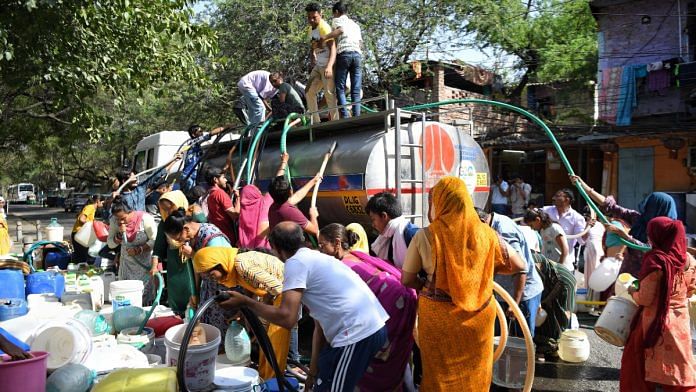New Delhi: India’s per capita water availability by 2030 is expected to be 1,367 cubic metres annually, the Jal Shakti ministry informed the Rajya Sabha on Monday, adding that anything less than 1,700 cubic metres per capita is considered a water-stressed situation.
The government was responding to a question posed by Aam Aadmi Party MP (Sant) Balbir Singh on the measures implemented in response to a World Wide Fund for Nature (WWF) report that flagged 30 cities in India that will face water scarcity by 2050.
Singh also asked whether the government was aware of the water scarcity issue in Bengaluru, which had led to the closing down of educational institutions.
In its response, the Ministry of Jal Shakti said it was aware of the 2020 report by the World Wide Fund for Nature (formerly the World Wildlife Fund), and the Central Water Commission (CWC) had calculated the per capita water availability in India in 2030 and 2050.
According to the CWC, by 2030 India’s annual per capita water availability will be 1,367 cubic metres, and by 2050, it will be 1,228 cubic metres. The statement also said that anything less than 1,700 cubic metres annually is considered a water-stressed condition, while less than 1,000 cubic metres is a water-scarcity condition. However, since water is a state subject and is primarily managed by state governments, the ministry said that the Centre only provides “technical and financial assistance”.
Also read: Delhi wetlands going extinct. To be found in govt files only
Schemes for water availability, state imbalances
The Ministry of Jal Shakti, in its response, also outlined the progress made by the central government’s various groundwater, rainwater harvesting and water supply schemes. For example, the Jal Jeevan Mission, launched to supply tap water to rural households, added a total of 11.78 crore households to the water supply grid between 2019 to 2024. However, ministry data showed that this expansion has been uneven across states, with some like Arunachal Pradesh achieving water supply for 100 percent of households, while West Bengal and Rajasthan stand at 50 and 51 percent respectively.
The ministry also highlighted other schemes such as the Atal Mission for Rejuvenation and Urban Transformation (AMRUT) 2.0, which was launched in 2021 to revitalise urban infrastructure for water supply in towns and cities in India. A total of Rs 39,011 crore had been set aside for the water supply sector under this project to make Indian cities “water secure”, the ministry said.
Another such scheme is the Jal Shakti Abhiyan: Catch the Rain Scheme (JSA-CRS) launched by the Jal Shakti Ministry between 2021 and 2024. The scheme was a convergence of various other schemes such as MGNREGS, AMRUT and the Pradhan Mantri Krishi Sinchayee Yojana, and had multiple funding sources including corporate social responsibility grants, CAMPA grants and Finance Commission Grants.
The ministry provided year-wise progress of this JSA-CRS initiative of every state. However, there were outliers in this, too.
Delhi, for example, has only completed 111 ‘rainwater harvesting and water conservation’ projects, 35 ‘renovation of traditional water bodies’ projects, and zero projects for the ‘reuse and recharge of structures’ and ‘watershed development’ since 2021. This is in glaring contrast to states like Andhra Pradesh and Kerala, or even smaller states like Sikkim, that have implemented hundreds of projects under each of these categories in the past 4 years.
The 2020 WWF report highlighted the extreme water risk faced by 100 cities around the world, home to around 350 million people. Out of these 100 cities, 30 were in India, including Delhi, Bengaluru, Jaipur, Indore, Mumbai, and Kolkata. Other global cities include Beijing, Istanbul and Rio de Janeiro. The report was formulated using the WWF’s Water Risk Filter, which analyses pathways and scenarios for water risk faced by countries and cities based on socio-economic and population factors.
(Edited by Sanya Mathur)




